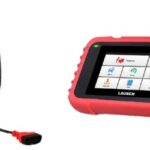This guide provides a comprehensive walkthrough on how to use VCDS (VAG-COM) to perform modifications and diagnostics on a 2013 Audi S7. VCDS allows access to various control modules in your vehicle, enabling customization and troubleshooting. We’ll cover connecting to your vehicle, interpreting diagnostic data, and implementing common modifications.
Getting Started with VCDS
Before diving in, ensure you have the necessary equipment:
- Laptop: Loaded with a compatible version of the Ross-Tech VCDS software.
- VCDS Cable: A genuine Ross-Tech cable is crucial for reliable communication. Counterfeit cables can cause issues.
Connecting to Your Audi S7
- Locate the OBD-II Port: The OBD-II port in your 2013 Audi S7 is located beneath the steering wheel, just above the hood release lever. It’s a purple connector.
- Connect the VCDS Cable: Plug the VCDS cable into the OBD-II port and connect the other end to your laptop’s USB port.
- Ignition ON: Turn the ignition to the “Accessory” position (press the start button once without your foot on the brake). VCDS will not function without the ignition in this mode.
- Launch VCDS Software: Open the Ross-Tech VCDS software on your laptop.
Verifying the Connection
-
Options and Test: In the VCDS software, click “Options” in the lower right corner, then select the “Test” button under “Port and Protocol” options.
-
Confirm “Ready” Status: After a few seconds, a status window will appear. Ensure the “Status” indicates “Ready” to confirm a successful connection.
-
Save and Return: Click “Save” in the options window and return to the main VCDS screen.
Accessing Control Modules and Performing Modifications
From the main screen, you can select various control modules to access their specific functions and settings. Common modifications and diagnostic procedures include:
-
Reading Fault Codes: Identify and clear diagnostic trouble codes (DTCs) to troubleshoot issues.
-
Data Logging (Performance Logs): Record live data from various sensors and systems to analyze performance and identify problems. To perform a performance log, select the desired control module, go to “Measuring Blocks – 08”, select the relevant measuring blocks (groups of data points), and start logging. Consult the Ross-Tech wiki for specific measuring block groups for different engine codes and desired data.
-
Adjusting Coding: Modify specific settings within control modules to customize features such as lighting, convenience features, and more. Always note down original coding values before making changes. Use the “Long Coding Helper” for assistance.
-
Accessing Hidden Menus: Some hidden menus offer additional settings and diagnostic information.
To access the hidden menu, hold down the “Car” and “Menu” buttons together for 5 seconds.
To reset the MMI 3G+, simultaneously press the “Menu” button, the large central control knob, and the top right soft button. Exercise caution within hidden menus and avoid the “Bootloader” section.
Important Considerations
- Backup Original Settings: Before making any modifications, always record the original coding and adaptation values. This allows you to revert to the factory settings if needed.
- Research Thoroughly: Understand the implications of any modifications before implementing them. The Ross-Tech wiki (wiki.ross-tech.com) is an invaluable resource.
- Seek Expert Advice: If you’re unsure about any procedure, consult with a qualified Audi technician or experienced VCDS user.
Conclusion
VCDS offers a powerful toolset for customizing and diagnosing your 2013 Audi S7. By following this guide and exercising caution, you can unlock hidden features and troubleshoot potential problems. Remember to thoroughly research any modifications and back up your original settings before making changes. Leverage the wealth of information available online and from Ross-Tech to maximize your VCDS experience.

